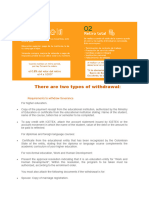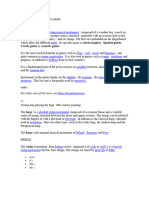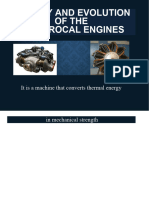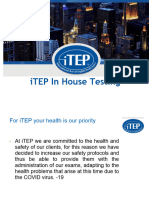Oral Language Evaluation Sheet
Oral Language Evaluation Sheet
Uploaded by
ScribdTranslationsCopyright:
Available Formats
Oral Language Evaluation Sheet
Oral Language Evaluation Sheet
Uploaded by
ScribdTranslationsOriginal Description:
Copyright
Available Formats
Share this document
Did you find this document useful?
Is this content inappropriate?
Copyright:
Available Formats
Oral Language Evaluation Sheet
Oral Language Evaluation Sheet
Uploaded by
ScribdTranslationsCopyright:
Available Formats
UNIVERSITY SANTO TOMAS
Special Education
Diagnosis of oral language disorders – Professor: Mabel Aravena Andia
ORAL LANGUAGE EVALUATION SHEET
Name: ________________________________________________________________________
Date of Birth: ___________________________ Age : ___________________________
Course: ____________________________ Evaluation Date:
______________________
1. PHONOARTICULATORY ORGANS:
Face: ______ Bone symmetry ______ Musculature ______ Expressiveness
Nostrils: Appearance: _____ Normal _____ Large _____ Small ____Asymmetrical
Permeability: ____ Normal ______Altered
Lips: Superior: ______Normal ______Short ______Fissured
Lower: ______Normal ______Everted
Lip tone: ______Normal ______Flaccid
Lip contact: ______Present ______Absent
Language: Size: ______Normal ______Macroglossia ______ Microglossia
Tonicity: ______Normal ______Insufficient ______ Exaggerated
Bridle: ______Normal ______Short ______Functional short
Palate: Hard: ______Normal ______Ogival ______Fissured
Uvula: ______Normal______Short ______ Bifid ______Absent
Tonsils: ______Normal______Hypertrophic______Absent
Bite: ______Normal______Altered (cover, bis a bis, inverted, open)
Dental Implantation: ______Normal ______Altered
2. OROFACIAL PRAXIAS.
Maxillae:___ Protrusion ___ Retrusion ___ Lateralization ___ Opening ___ Closing
Lipstick: ___ Protrusion ___ Retrusion ___ Lateralization ___ Clicking ___ Vibration
Lingual:___ Elevation ___ Alveolus ___ Clicking ___ Lateralization ___ Vibration
___ Coordination ___ Accuracy ___ Strength ___ Reach ___
Cheeks: ___ Inflate ___ Deflate
3. PRELINGUISTIC FUNCTIONS.
Breathing: Mode: ___ Nasal ___ Mixed ___ Buccal
Type: ___ Suitable ___ High costal ___ Costodiaphragmatic ___ Abdominal
Blow: ___ Direction ___ Force ___ Scope
Mastication : ___ Normal ___ Bilateral Preference
___ Left unilateral preference
___ Unilateral preference right.
Swallowing: ___ Normal ___ Atypical
___ Compensatory Movements
___ Lingual Interposition
___ Lip Suction
___ Waste in Lobby
UNIVERSITY SANTO TOMAS
Special Education
Diagnosis of oral language disorders – Professor: Mabel Aravena Andia
4. HEARING.
Hearing Acuity: _______ Functional_______ Not functional
Auditory Discrimination: _______ Non-verbal _______ Phonemics
5. VOICE.
Intensity: _______ Normal _______ Strong _______ Weak
Tone: _______ Normal _______ Sharp _______ Serious _______ Bitonal
Resonance: _______ Normal _______ Hypernasal _______ Hyponasal
6. SPEAKS.
Phonetic Repertoire _______ Complete
_______ Articulatory inconsistency
_______ Dyslalias: ___________________________________________
_______ I mumble
_______ Bradilalia _______ Taquilalia
_______ Disfluency _______ Tonic _______ Clonic _______ Tonic-Clonic
7. LANGUAGE.
PHONOLOGICAL LEVEL :
Expressive:
- Vowel diphones : au ai ei eu ia ie io iu oi ua ue ui uo
- Consonant diphones: pl fl kl bl gl tl pr fr kr tr br gr dr
- Metrics : __ Disyllables __ Trisyllables __
Polysyllables
- Trabantes :__ Good production __ Omit __ Replaces
Comprehensive:
- Non-verbal auditory discrimination :__Identifies sound source
__Identifies location of the sound source
- Auditory verbal discrimination : __ Auditory discrimination of phonemes
__ Auditory word discrimination
- Auditory Memory : __ Good __ Regular __ Bad
SEMANTIC LEVEL :
Expressive :
- Spontaneous vocabulary: __ Adequate __ Poor
- Denomination: __ Parts of the body __ Animals __ Objects (3.0 years)
__ Actions __ Clothing
__ Toiletries
__ Colors (3.6 years)
__ Fruits vegetables (4.0 years)
__ School Supplies __ Means of transport
__ Geometric figures
- Lexical fluency: (at least 2 elements)
Body parts ___________________________________
Animals _________________________________________
Clothing ___________________________________
Cleaning supplies ______________________________________
Fruit ____________________________________________
UNIVERSITY SANTO TOMAS
Special Education
Diagnosis of oral language disorders – Professor: Mabel Aravena Andia
Vegetables __________________________________________
School Supplies _____________________________________
Means of transport _________________________________
- Identification by use: What do we use it for?
Broom : ____________________________________________
Bed : ____________________________________________
Comb : ____________________________________________
Pencil : ____________________________________________
- Definitions : __ Does not define
__ By function (3.0 years)
__ By description and/or function (4.0 years)
__ By categorization and description and/or function (5.0 years)
Comprehensive
- Passive vocabulary : __ Adequate __ Poor
- Categorization:
- Body Parts: __ Eyes __ Shoes __ Arm
- Animals: __ Pencil __ Dog __ Lion
- School supplies: __ Rubber __ Notebook __ Vest
- Fruit : __ Banana __ Meat __ Orange
Lexicological relations:
- Verbal similarities: How are they similar?
- chair – armchair ____________________________________________
- fork spoon ________________________________________
- knife – scissors _______________________________________
- pear – banana ___________________________________________
- Analogies: Complete the sentences
- The elephant is big. The mouse is ______________
- Socks are put on the feet. Gloves are put on ______________
- The sun rises during the day. The moon rises from ______________
- The pencil is for writing. Rubber is used to ________________
MORPHOSYNTACTIC LEVEL:
Expressive
Length of statements: ______Holophrase
______Grammar Pivot
______Simple (a+s) (a+s+adj)
______M. complex (a+s+v) (a+s+v+CD)
______Complex (a+s+v+CD/CI/CC/clause)
It presents alterations of: ______ Agreement (Gº - Nº - Verbs)
Omission ______ (prep. – Adv – Art)
Others _____________________________________
Grammatical Elements: __ Articles __ Gender __ Number __ Adjectives
__ Prepositions __ Pronouns __ Verb tenses
Comprehensive
- Headers:
What____ Who ____ When ____ Where ____ Which____ With whom ____ Why ____
- Answer questions: __ Personal __ Open __ Closed
- Obeys orders: __ Simple __ Complex
UNIVERSITY SANTO TOMAS
Special Education
Diagnosis of oral language disorders – Professor: Mabel Aravena Andia
- General understanding during the evaluation: __ Good __ Poor
PRAGMATICS:
Communicative Intentions: Presents _____________ Absent ______________
Communication Mode: Verbal _____________ Gestural ______________
Topic Management: Appropriate _____________ Inappropriate ____________
Taking Turns: Appropriate _____________ Inappropriate ____________
Non-Verbal Aspects: Eye Contact _______________________________
Posture ______________________________________
Attention/Concentration _________________________
Memory _____________________________________
NARRATIVE SPEECH:
Categories:
Framework or scenario
_____ Character and his attributes.
_____ Space and time.
_____ Initial problem or event that generates the story.
Episode(s)
_____ Goal or objective that drives the character.
_____ Actions you take to achieve the goal.
_____ Obstacles that hinder achievements.
_____ Results or consequences of obstacles.
Final
_____ Absent
_____ Abrupt
_____ Complete
Content organization:
_____ Local coherence
_____ Global coherence
Stadium:
_____ Enumerative grouping (between 2 and 3 years).
_____ Sequence of actions around a character (at 3 years old).
_____ Primitive narratives (from 4 years to 4 years 6 months).
_____ Narrative chains or narratives with incomplete episodes (from 4 years and 6 months
up to 5 years).
_____ True narratives (from 5 years to 7 years).
8. OBSERVATIONS.
_________________________________________________________________________________
_________________________________________________________________________________
_________________________________________________________________________________
9. DIAGNOSTIC HYPOTHESIS.
_________________________________________________________________________________
_________________________________________________________________________________
_________________________________________________________________________________
You might also like
- Gordon S Functional Health Pattern Assessment ToolDocument17 pagesGordon S Functional Health Pattern Assessment Toolmiss RN96% (45)
- Slumdog Millionaire Booklet CompressedDocument62 pagesSlumdog Millionaire Booklet CompressedRhea GnanapandithenNo ratings yet
- Spanish I Final Review PacketDocument6 pagesSpanish I Final Review PacketJoaquin100% (3)
- Vergados - The Homeric Hymn To Hermes - Introduction, Text and Commentary-Walter de Gruyter (2012)Document733 pagesVergados - The Homeric Hymn To Hermes - Introduction, Text and Commentary-Walter de Gruyter (2012)saffaroo100% (1)
- Family Heritage AssignmentDocument5 pagesFamily Heritage Assignmenttv58611No ratings yet
- Sltndlanguage, Unfavfavrble - Negative, Posivtive NeutralDocument5 pagesSltndlanguage, Unfavfavrble - Negative, Posivtive NeutralanghelginezNo ratings yet
- Have Has Affirm Neg Interrogwith AliensDocument1 pageHave Has Affirm Neg Interrogwith AliensAdriana Cerqueira CorreaNo ratings yet
- English File Pre Int VocabularyDocument30 pagesEnglish File Pre Int VocabularyPiroska FarkasNo ratings yet
- Developmental History Form 2016Document5 pagesDevelopmental History Form 2016Mariya KhanNo ratings yet
- TOIEC Study Tour GuideDocument90 pagesTOIEC Study Tour GuideZed ExeNo ratings yet
- ING7 Resumo2017 Outubro (Completar)Document5 pagesING7 Resumo2017 Outubro (Completar)Ana Rita Valente ValenteNo ratings yet
- Functional Health Patterns Assessment ToolDocument4 pagesFunctional Health Patterns Assessment ToolKim Caitlin Carbolico Clasiete100% (1)
- 5º Andrea Tema 1Document16 pages5º Andrea Tema 1AlbaVozmedianoRodillaNo ratings yet
- Speaking WorksheetDocument2 pagesSpeaking WorksheetgiseNo ratings yet
- Head To Toe Assessment - 1Document2 pagesHead To Toe Assessment - 1sleeNo ratings yet
- 7 - Create A Baby LabDocument4 pages7 - Create A Baby Labapi-375285021No ratings yet
- ( ) 531 H 4Document52 pages( ) 531 H 48dwmqbcqg9No ratings yet
- Student InventoryDocument2 pagesStudent Inventoryleo dumapiNo ratings yet
- Adult Case HistoryDocument9 pagesAdult Case HistoryAYAZ AHMAD KHANNo ratings yet
- Cagayan de Oro City College of Nursing Assessment FormDocument12 pagesCagayan de Oro City College of Nursing Assessment Formsticdo_nursing2011No ratings yet
- Ca HandoutDocument34 pagesCa HandoutNgọc Huyền Nguyễn ThịNo ratings yet
- 2020 2021 PortfolioDocument44 pages2020 2021 Portfoliojvollamina29No ratings yet
- PATIENT - HISTORY - FORM Final-20130611 PDFDocument6 pagesPATIENT - HISTORY - FORM Final-20130611 PDFUloko ChristopherNo ratings yet
- Avanzado 4 FINALDocument4 pagesAvanzado 4 FINALEdgar LaraNo ratings yet
- Health Perception-Health Management Pattern ObjectiveDocument7 pagesHealth Perception-Health Management Pattern ObjectiveTammy SherryNo ratings yet
- Functional Health Patterns Assessment Tool (Patient'S Profile)Document7 pagesFunctional Health Patterns Assessment Tool (Patient'S Profile)Kyrá BadayosNo ratings yet
- Gastrointestinal System - TestDocument1 pageGastrointestinal System - TestDanielAntonioValderramaMerejildoNo ratings yet
- Culture and MulticulturalismDocument3 pagesCulture and MulticulturalismMarisa SilvaNo ratings yet
- Nursing Assessment According To GordonDocument3 pagesNursing Assessment According To GordonJelai DNo ratings yet
- Pisno Ocenjevanje Znanja Za Oceno Št. 2 6. RazredDocument5 pagesPisno Ocenjevanje Znanja Za Oceno Št. 2 6. Razredsrce123No ratings yet
- 3ta Pismena 3ta God GR 2Document2 pages3ta Pismena 3ta God GR 2Зорица ДимовскаNo ratings yet
- Final Test Superkids I d4Document3 pagesFinal Test Superkids I d4danoeun100% (4)
- AppForm 11111HSDocument6 pagesAppForm 11111HSvainly4u8155No ratings yet
- Suffixes 1 2 PDFDocument4 pagesSuffixes 1 2 PDFนาย จักรกฤษณ์ บุญมากNo ratings yet
- ODF4 Unit 9 TestDocument7 pagesODF4 Unit 9 TestwillaygNo ratings yet
- Comprens I On Lector A 2012Document2 pagesComprens I On Lector A 2012Maria Marta VilanovaNo ratings yet
- Classes TestsDocument3 pagesClasses Testsenayatullah12jamaliNo ratings yet
- Live @,upbringing, Schooling, Marriage: When:, S/O:, Home SituationsDocument5 pagesLive @,upbringing, Schooling, Marriage: When:, S/O:, Home SituationsJoy SalvadorNo ratings yet
- CN Personality, Gustar, Sentence StructureDocument4 pagesCN Personality, Gustar, Sentence StructureJoaquin HernandezNo ratings yet
- Spelling HW 24 Sept 10Document1 pageSpelling HW 24 Sept 10jahkiNo ratings yet
- Untitled DocumentDocument5 pagesUntitled Documentapi-421888884No ratings yet
- Speech Therapy Evaluation Guideline For Orofacial Motor Skills 2016Document11 pagesSpeech Therapy Evaluation Guideline For Orofacial Motor Skills 2016ScribdTranslationsNo ratings yet
- Review Packet of 7th Grade SpanishDocument13 pagesReview Packet of 7th Grade SpanishZachary ParverNo ratings yet
- Folder Unit 7-JourneysDocument36 pagesFolder Unit 7-JourneysCarla Sánchez HernándezNo ratings yet
- Vocabulary Bank Numbers 1 A (Numbers 0-20) : Zero 0Document16 pagesVocabulary Bank Numbers 1 A (Numbers 0-20) : Zero 0Dubravka KovacevicNo ratings yet
- Developmental History QuestionnaireDocument6 pagesDevelopmental History QuestionnaireMariana RzNo ratings yet
- Gordons Functional Health Pattern Assessment Tool (Bano, R.)Document3 pagesGordons Functional Health Pattern Assessment Tool (Bano, R.)ojay880% (1)
- Talking About Oneself, School Subjects, Hobbies and Professions. ADocument8 pagesTalking About Oneself, School Subjects, Hobbies and Professions. ASABRINA0% (1)
- Speech HistoryDocument2 pagesSpeech HistorySandra Pogoy AñascoNo ratings yet
- Usos de Bite Blocks PDFDocument25 pagesUsos de Bite Blocks PDFNatasha RiveraNo ratings yet
- Chapter - 1 - KRUDEW - TOEIC - 2020 - สำเนาDocument48 pagesChapter - 1 - KRUDEW - TOEIC - 2020 - สำเนาkritsadaarmatmonteeNo ratings yet
- Acumulativas Ingles-SecundariaDocument12 pagesAcumulativas Ingles-Secundariafivefold gtNo ratings yet
- Human Body: Intro 2Document6 pagesHuman Body: Intro 2Juan David Leal CampuzanoNo ratings yet
- Beginners Sight and Read: Parent Pack For Strong Foundational Level Series 1From EverandBeginners Sight and Read: Parent Pack For Strong Foundational Level Series 1No ratings yet
- Practice with Prepositions in Everyday English, Advanced LevelFrom EverandPractice with Prepositions in Everyday English, Advanced LevelRating: 1 out of 5 stars1/5 (1)
- Practice with Prepositions in Everyday English, Intermediate LevelFrom EverandPractice with Prepositions in Everyday English, Intermediate LevelRating: 3.5 out of 5 stars3.5/5 (4)
- Vocabulary, Grades 2 - 3: Activities That Support Research-Based InstructionFrom EverandVocabulary, Grades 2 - 3: Activities That Support Research-Based InstructionRating: 4 out of 5 stars4/5 (1)
- Practicing with Prepositions in Everyday English Beginner LevelFrom EverandPracticing with Prepositions in Everyday English Beginner LevelRating: 3 out of 5 stars3/5 (3)
- Practice Makes Perfect: Advanced English Grammar for ESL Learners, Second EditionFrom EverandPractice Makes Perfect: Advanced English Grammar for ESL Learners, Second EditionRating: 5 out of 5 stars5/5 (1)
- Natural History of Parkinson's DiseaseDocument49 pagesNatural History of Parkinson's DiseaseScribdTranslationsNo ratings yet
- Retirement Instructions Unemployment PorvenirDocument6 pagesRetirement Instructions Unemployment PorvenirScribdTranslationsNo ratings yet
- Application of Copper Sulfate in AquacultureDocument2 pagesApplication of Copper Sulfate in AquacultureScribdTranslationsNo ratings yet
- Abbreviated File-Process Case 01 Marco A. and CounterclaimDocument25 pagesAbbreviated File-Process Case 01 Marco A. and CounterclaimScribdTranslationsNo ratings yet
- Ethnicity, Language and IdentityDocument4 pagesEthnicity, Language and IdentityScribdTranslationsNo ratings yet
- Mug With Reindeer - en - EsDocument19 pagesMug With Reindeer - en - EsScribdTranslations100% (1)
- PH Portfolio Recovery ProposalDocument3 pagesPH Portfolio Recovery ProposalScribdTranslationsNo ratings yet
- Chapter X. Precision Shooting From Naval Air PlatformsDocument24 pagesChapter X. Precision Shooting From Naval Air PlatformsScribdTranslationsNo ratings yet
- Tourist PlanningDocument39 pagesTourist PlanningScribdTranslationsNo ratings yet
- Comparative Table of Rationalism and EmpiricismDocument7 pagesComparative Table of Rationalism and EmpiricismScribdTranslationsNo ratings yet
- Instructions Ford Ranger Obdi CodesDocument49 pagesInstructions Ford Ranger Obdi CodesScribdTranslations100% (1)
- Boxing PDFDocument49 pagesBoxing PDFScribdTranslationsNo ratings yet
- Musical Instruments of EuropeDocument3 pagesMusical Instruments of EuropeScribdTranslationsNo ratings yet
- Practical Work The Familiar PDFDocument1 pagePractical Work The Familiar PDFScribdTranslationsNo ratings yet
- History and Evolution of Reciprocating MotorsDocument32 pagesHistory and Evolution of Reciprocating MotorsScribdTranslationsNo ratings yet
- SYLLABUS Mechanical Drawing 2Document7 pagesSYLLABUS Mechanical Drawing 2ScribdTranslationsNo ratings yet
- iTEP in - House PDFDocument12 pagesiTEP in - House PDFScribdTranslationsNo ratings yet
- Reading Comprehension and Contextual Vocabulary Exercises 4th Middle #8.Document5 pagesReading Comprehension and Contextual Vocabulary Exercises 4th Middle #8.ScribdTranslationsNo ratings yet
- Expo22 Daily ExperienceDocument6 pagesExpo22 Daily ExperienceScribdTranslationsNo ratings yet
- Sixth Grade Reading Comprehension AssessmentDocument8 pagesSixth Grade Reading Comprehension AssessmentScribdTranslationsNo ratings yet
- Legal Aspects GuatemalaDocument20 pagesLegal Aspects GuatemalaScribdTranslationsNo ratings yet
- 5th Grade Plan - Block 4 GeographyDocument12 pages5th Grade Plan - Block 4 GeographyScribdTranslationsNo ratings yet
- Applied StatisticsDocument209 pagesApplied StatisticsScribdTranslationsNo ratings yet
- Project On Electricity For ChildrenDocument13 pagesProject On Electricity For ChildrenScribdTranslationsNo ratings yet
- Types of Banks Based On OwnershipDocument2 pagesTypes of Banks Based On OwnershipScribdTranslationsNo ratings yet
- Security of Accounting Information SystemsDocument2 pagesSecurity of Accounting Information SystemsScribdTranslationsNo ratings yet
- Driver's Manual in TexasDocument109 pagesDriver's Manual in TexasScribdTranslationsNo ratings yet
- Application of Regulations in The Financial SystemDocument74 pagesApplication of Regulations in The Financial SystemScribdTranslationsNo ratings yet
- Chemistry Laboratory Report 1Document14 pagesChemistry Laboratory Report 1ScribdTranslationsNo ratings yet
- Vibrational Sound Therapy ManualDocument12 pagesVibrational Sound Therapy ManualScribdTranslations100% (1)
- Short Narrative Lesson Plan 1Document2 pagesShort Narrative Lesson Plan 1api-632126109No ratings yet
- Solved CAT 2020 Slot 3 Paper With Solutions PDFDocument25 pagesSolved CAT 2020 Slot 3 Paper With Solutions PDFnaveengargnsNo ratings yet
- African LiteratureDocument12 pagesAfrican LiteratureMokhtar BentaharNo ratings yet
- 25699562Document12 pages25699562duckythiefNo ratings yet
- Literature Review Webster WatsonDocument7 pagesLiterature Review Webster Watsongw08nnfr100% (1)
- Q1 Mod3 PDFDocument28 pagesQ1 Mod3 PDFmary rose89% (19)
- The Feminist Postmodern Ontology: The Case of Marianne Wiggins' John DollarDocument8 pagesThe Feminist Postmodern Ontology: The Case of Marianne Wiggins' John DollarIJELS Research JournalNo ratings yet
- Qualitative Data Analysis Methods and TechniquesDocument7 pagesQualitative Data Analysis Methods and Techniquessisay gebremariamNo ratings yet
- LRM NotesDocument43 pagesLRM NotesNeelesh Bhandari100% (1)
- CNFW Lesson 6Document7 pagesCNFW Lesson 6Wayne Dolorico MillamenaNo ratings yet
- Written Output 1Document5 pagesWritten Output 1Regienald Bryant100% (1)
- Narrative Essay Marking SchemeDocument2 pagesNarrative Essay Marking Schemegocan12-1100% (1)
- Representations of Rape in Popular Culture Gone Girl and BadlapurDocument6 pagesRepresentations of Rape in Popular Culture Gone Girl and BadlapurAbhishek RajNo ratings yet
- Satchidandanan On BasheerDocument23 pagesSatchidandanan On BasheerroseNo ratings yet
- Mark As Story - An Introduction To The Narrative of A GospelDocument175 pagesMark As Story - An Introduction To The Narrative of A Gospelartevita2023cucutaNo ratings yet
- Klingmann BRANDSCAPESDocument12 pagesKlingmann BRANDSCAPESpbhansenNo ratings yet
- Kpds Paragraf Doldurma1Document23 pagesKpds Paragraf Doldurma1Bekir KaracaNo ratings yet
- Contemporary Philippine Arts From The Regions Philippine Literature: Forms, Elements and PrinciplesDocument10 pagesContemporary Philippine Arts From The Regions Philippine Literature: Forms, Elements and Principlesshiella mae baltazar100% (4)
- CS1 English Teacher Guide v.2 2011Document162 pagesCS1 English Teacher Guide v.2 2011Sylva Sagita100% (1)
- Definition of Narrative TextDocument6 pagesDefinition of Narrative TextKomala DewiNo ratings yet
- HT-UNIT 5 Task SheetDocument3 pagesHT-UNIT 5 Task SheetJúlia RochaNo ratings yet
- Alfian Fahmi - Dokumen SkripsiDocument101 pagesAlfian Fahmi - Dokumen SkripsiVerawati Raisya ToyaNo ratings yet
- Ivans ChildhoodDocument21 pagesIvans ChildhoodsergeNo ratings yet
- Cultural Studies, Multiculturalism, and Media Culture - D. KellnerDocument12 pagesCultural Studies, Multiculturalism, and Media Culture - D. KellnerSilvana TorresNo ratings yet
- Article 15111Document8 pagesArticle 15111Mikaela Albuen VasquezNo ratings yet
- Song Analysis of 'Gloomy Sunday' in Literature Perspective: Submitted byDocument71 pagesSong Analysis of 'Gloomy Sunday' in Literature Perspective: Submitted byMul AdiNo ratings yet
- Setting Notes - AP Short StoryDocument2 pagesSetting Notes - AP Short StoryRyanGoldenNo ratings yet
- Introduction To Literature II: Gul Aizaz Department of English Abdul Wali Khan University MardanDocument35 pagesIntroduction To Literature II: Gul Aizaz Department of English Abdul Wali Khan University Mardanali khanNo ratings yet























































































































